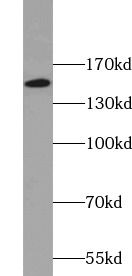Products
KIF15 antibody
| Synonyms: | Kinesin-like protein KIF15|Kinesin-like protein 2 (hKLP2)|Kinesin-like protein 7|Serologically defined breast cancer antigen NY-BR-62|KIF15|KLP2|KNSL7 antibody | ||
| Catalogue No.: | FNab04551 | Reactivity: | Human, Mouse, Rat |
| Host: | Rabbit | Tested Application: | ELISA, WB, IHC, IF, IP |
| Clonality: | polyclonal | Isotype: | IgG |
| Size | Price |
|---|---|
| 100µg | Inquiry |
- SPECIFICATIONS
- CITATIONS
- FIGURES
- CONDITIONS
- FAQS
- Product Name
- KIF15 antibody
- Catalogue No.
- FNab04551
- Size
- 100μg
- Form
- liquid
- Purification
- Immunogen affinity purified
- Purity
- ≥95% as determined by SDS-PAGE
- Clonality
- polyclonal
- Isotype
- IgG
- Storage
- PBS with 0.02% sodium azide and 50% glycerol pH 7.3, -20℃ for 12 months(Avoid repeated freeze / thaw cycles.)
- Immunogen
- kinesin family member 15
- Alternative Names
- Kinesin-like protein KIF15|Kinesin-like protein 2 (hKLP2)|Kinesin-like protein 7|Serologically defined breast cancer antigen NY-BR-62|KIF15|KLP2|KNSL7 antibody
- UniProt ID
- Q9NS87
- Observed MW
- 160 kDa
- Tested Applications
- ELISA, WB, IHC, IF, IP
- Recommended dilution
- WB: 1:500-1:2000; IP: 1:500-1:1000; IHC: 1:20-1:200; IF: 1:20-1:200
 mouse thymus tissue were subjected to SDS PAGE followed by western blot with FNab04551(KIF15 antibody) at dilution of 1:500
mouse thymus tissue were subjected to SDS PAGE followed by western blot with FNab04551(KIF15 antibody) at dilution of 1:500
 IP Result of anti-KIF15 (IP: FNab04551, 4ug; Detection: FNab04551 1:500) with mouse thymus tissue lysate 3000ug.
IP Result of anti-KIF15 (IP: FNab04551, 4ug; Detection: FNab04551 1:500) with mouse thymus tissue lysate 3000ug.
 Immunohistochemistry of paraffin-embedded human testis using FNab04551(KIF15 antibody) at dilution of 1:50
Immunohistochemistry of paraffin-embedded human testis using FNab04551(KIF15 antibody) at dilution of 1:50
- Background
- KIF15, also named as KLP2 and KNSL7, belongs to the kinesin-like protein family and KLP2 subfamily. It is a plus-end directed kinesin-like motor enzyme which involved in mitotic spindle assembly. Several isoforms of KIF15 exist due to the alternative splicing, with molecular weight between 130-160 kDa. Sometimes higher molecular weight around 200 kDa can also be observed, which may be a modified variant of KIF15.
- Journal:
- Cell Death Discovery
- Author:
- Department of Urology, Shanghai General Hospital, Shanghai Jiaotong University School of Medicine, 200080, Shanghai, China
- Cited Date:
- 2023-09-08
- Product:
- Journal:
- American Journal of Cancer Research
- Author:
- Department of Colorectal Surgery, Fudan University Shanghai Cancer Center, 270 Dong’an Road, Shanghai 200032, China
- Cited Date:
- 2023-11-24
- Product:
- Journal:
- AGING
- Cited Date:
- 2020-10-15
- Product:
- Journal:
- European Journal of Cell Biology
- Cited Date:
- 2021-11-26
- Product:
- Journal:
- Heliyon
- Author:
- First Affiliated Hospital of Shenzhen University/Shenzhen Second People's Hospital, Shenzhen, Guangdong, 518000, China
- Sample:
- chordoma tissues
- Cited Date:
- 2024-04-19
- Product:
- Journal:
- Cancer Cell International
- Cited Date:
- 2020-04-15
- Product:
- Journal:
- Oncology Reports
- Cited Date:
- 2020-02-21
- Product:
- Journal:
- Current Molecular Medicine
- Cited Date:
- 2019-05-20
- Product:
- Journal:
- BIOCELL
- Author:
- Department of Otolaryngology & Head and Neck, The First Affiliated Hospital of Guangxi Medical University, Nanning, 530021, China
- Cited Date:
- 2023-06-09
- Product:
- Journal:
- Research Square
- Cited Date:
- 2021-04-23
- Product:
How many times can antibodies be recycled?
First, usually it's not suggested to recycle antibodies. After use, buffer system of antibodies has changed. The storage condition of recycled antibodies for different customers also varies. Thus, the performance efficiency of recycled antibodies can’t be guaranteed. Besides, FineTest ever conducted the antibody recycling assay. Assay results show recycling times of different antibodies also varies. Usually, higher antibody titer allows more repeated use. Customers can determine based on experimental requirements.
Notes: After incubation, we recycle rest antibodies to centrifuge tube and store at 4℃. High titer antibodies can be stored for a minimum of one week. Reuse about three times.
What are components of FineTest antibody buffer?
Components of FineTest antibody buffer are usually PBS with proclin300 or sodium azide, BSA, 50% glycerol. Common preservative is proclin300 or sodium azide, which is widely applied in the lab and industry.
How about the storage temperature and duration of FineTest antibodies?
Most antibodies are stored at -20℃. Directly-labeled flow cytometry antibodies should be stored at 2 - 8℃. The shelf life is one year. If after sales issues for purchased antibodies appear, return or replacement is available. Usually, antibodies can be still used after the one-year warranty. We can offer technical support services.
Is dilution required for FineTest antibodies? What’s the dilute solution?
Directly-labeled flow cytometry antibodies are ready-to-use without dilution. Other antibodies are usually concentrated. Follow the dilution ratio suggested in the manual. Dilute solution for different experiments also varies. Common antibody dilution buffers are acceptable(e.g. PBST, TBST, antibody blocking buffer).
How to retrieve antibodies for immunohistochemistry?
Common retrieval buffers: Tris-EDTA Buffer(pH 9.0); Citrate Buffer(pH 6.0)
Heat induced antibody retrieval:
Method 1: Water-bath heating: Put the beaker with retrieval buffer and slide in the boiling water bath. Keep the boiling state for 15min. Naturally cool to room temperature;
Method 2: Microwave retrieval: Put the beaker with retrieval buffer and slide in the microwave oven. Heat at high power for 5min, Switch OFF for 3min, Heat at medium power for 5min. Naturally cool to room temperature.
How to choose secondary antibodies?
(1) Secondary antibodies react with primary antibodies. Thus, secondary antibodies should be against host species of primary antibodies. E.g. If the primary antibody is derived from rabbit, the relevant secondary antibody should be against rabbit. E.g. goat anti rabbit or donkey anti rabbit.
(2) Choose secondary antibody conjugates according to the experimental type, e.g. ELISA, WB, IHC etc. Common enzyme conjugated secondary antibodies are labelled by HRP, AP etc. Fluorescin or dye labelled secondary antibodies are applied in immunofluorescence and flow cytometry(e.g. FITC, Cy3).
